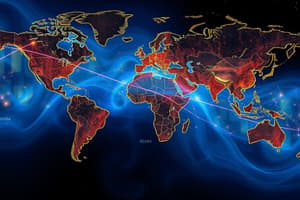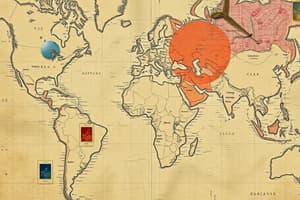Podcast
Questions and Answers
What factor has a significant influence on people's perception of safety?
What factor has a significant influence on people's perception of safety?
- Cultural experience
- Actual crime rates (correct)
- Public transportation
- Business activity
Perception of crime is always an accurate reflection of actual crime rates.
Perception of crime is always an accurate reflection of actual crime rates.
False (B)
What does the Urban Liveability Index (EUI) use to rate cities?
What does the Urban Liveability Index (EUI) use to rate cities?
A score out of 100
Urbanisation is the gradual relocation of people into ____ towns and cities.
Urbanisation is the gradual relocation of people into ____ towns and cities.
Match the following factors with their categories:
Match the following factors with their categories:
Which of the following describes 'relative distance'?
Which of the following describes 'relative distance'?
Human geography solely focuses on the physical aspects of the earth.
Human geography solely focuses on the physical aspects of the earth.
What are push factors in human geography?
What are push factors in human geography?
A _______ scale on a map visually represents the distances as line segments.
A _______ scale on a map visually represents the distances as line segments.
Match the following terms to their definitions:
Match the following terms to their definitions:
Which of the following is considered a pull factor?
Which of the following is considered a pull factor?
Environmental resources include artificial resources developed by humans.
Environmental resources include artificial resources developed by humans.
What influence does socioeconomic conditions have on crime rates?
What influence does socioeconomic conditions have on crime rates?
Flashcards are hidden until you start studying
Study Notes
Scales
- Map scales tell us the relationship between the distance on a map and the real distance on the ground.
- Words: One centimetre represents one kilometre
- Ratio: 1: 100,000
- Linear Scales: A bar to show the length of a distance.
- Absolute Distance refers to the actual distance between two places.
- Relative Distance relates to the time it takes to get to a place .
Pie Graphs
- A pie graph is a circular chart that is divided into slices.
- Pie graphs display parts of a whole.
- Each slice represents a particular category and the size of its slice is in proportion to its share of the total.
- The legend indicates what each colour or shading represents.
Field Sketches
- A field sketch is a drawing created in the field that shows a landscape or environment.
- Field sketches are a visual record of the field studies conducted in the field.
- Field sketches should include a key for identifying different features. It should also include:
- Title
- Key/legend
- A compass direction (N/S/E/W) and scale
- A brief description of the scene.
Grid References
- Grid references help to locate places on a map.
- They consist of two numbers or letters that correspond to the horizontal and vertical lines on the map.
Human Geography
- Human geography is the study of people, their relationships with the land, and their impact on the environment.
- It looks at how people differ in different environments and how they adapt to their surroundings.
- It also analyzes how human activities such as agriculture, urbanization, and transportation affect the environment.
How Human Geography Impacts Place
- Liveability is a subjective assessment of how pleasant and desirable a place is to live in.
- People's perceptions of places are shaped by their interactions with the environment and human factors.
Glossary of Directive Words
- Analyse: To break down a subject and examine its parts in detail.
- Compare: To look for similarities and differences between two or more things.
- Contrast: To emphasize the differences between two or more things.
- Evaluate: To assess the worth or importance of something.
- Explain: To provide a clear and detailed explanation of something.
Types of Geographical Data
- Primary Data: Collected firsthand using methods like surveys, interviews, and field observations.
- Secondary Data: Data collected by others (e.g., census data, maps)
- Qualitative Data: Expressed in words and descriptions. Provides understanding using personal stories and experiences, opinions and judgements.
- Quantitative Data: Expressed in numerical form and can be measured. Helps us understand patterns and trends in a specific context.
Key Terms:
- Perception: How individuals understand and interpret places.
- Place: A geographical area with distinct characteristics and meaning to people.
- Liveability: How suitable a place is to live in, considering various factors.
Control
- Internal control refers to factors that are within a person's control and influence.
- External control refers to those factors beyond a person's control and influence.
Push and Pull Factors
- Pull factors are positive aspects of a place that attract people to live there.
- Push factors are negative aspects of a place that encourage people to leave.
Environmental Factors
- Environmental factors play a crucial role in influencing people's decisions about where to live.
- These include climate, natural resources, and landforms.
Geoshperes
- The geoshperes are the Earth's interconnected systems.
- These include: the biosphere (life), lithosphere (earth's crust), hydrosphere (water), and atmosphere (air).
Natural Resources
- Natural resources are materials found in nature that are used by people.
- Environmental resources are natural resources that originate directly from the biophysical environment, such as water, soil, wood, fish, minerals, and fossil fuels.
Crime and Safety
- Crime rates contribute to a sense of safety and can affect the liveability of a place.
- Socioeconomic factors significantly influence crime rates.
- Perception of safety is just as important as the actual crime rate.
Measuring Livability
- Liveability indexes use different measures to assess the quality of life in an area.
- Various factors include: housing, healthcare, education, infrastructure, cultural life, and environmental quality.
Urban Liveability Index (EUI)
- The EUI scores cities out of 100 based on various quality-of-life factors.
Urbanisation
- Urbanisation is the process of people moving into big towns and cities.
Human Factors Affecting Liveability
- Economic factors include unemployment rates, income levels, and business opportunities.
- Social factors include access to healthcare, education, and community facilities.
- Cultural factors include diversity, arts and entertainment, and social cohesion.
- Political factors include government stability, crime rates, and public safety.
Environmental Factors Affecting Livability
- Air quality is essential for health and well-being.
- Water quality is important for drinking, sanitation, and recreation.
- Climate affects people's physical and mental health.
Human Geography Inquiry Question:
- What are the factors that influence the liveability of a place?
- How do these factors interact and impact the overall quality of life in a place?
- How can we use our knowledge of human geography to improve the liveability of a place?
Questions
- How do people's perceptions of place influence their decision-making?
- What are the key factors that contribute to the liveability of a place?
- What are the challenges and opportunities associated with urbanisation?
Enhancing Liveability
- Urban planning: Designing cities that are efficient, sustainable, and inclusive.
- Investments in public transportation: Reducing traffic congestion and improving mobility.
- Improving accessibility to healthcare and education: Creating equitable access to essential services.
- Promoting community engagement: Building strong neighborhoods and social connections.
Bell Activity
- Map Skills: Practicing map reading and interpretation.
- Research Skills: Gathering data related to a specific geographical location.
- Problem-Solving: Identifying issues and suggesting potential solutions.
- Communication Skills: Sharing ideas and findings in a clear and concise way.
Improving Glenwood's Liveability
- Identifying key issues: What specific challenges impact Glenwood's liveability?
- Prioritizing solutions: What are the most important areas to focus on?
- Developing an action plan: How can Glenwood address these issues effectively?
Test Revision
- Review key concepts and definitions.
- Practice answering essay questions.
- Study maps and diagrams.
Sketching Basics
- Select a subject to sketch.
- Use basic shapes and lines to create an outline.
- Add details and shading to create more depth and realism.
Survey Basics
- Define the purpose of the survey.
- Develop clear and concise questions.
- Choose an appropriate sample size and sampling method.
- Analyse the data and draw conclusions.
Studying That Suits You
Use AI to generate personalized quizzes and flashcards to suit your learning preferences.




